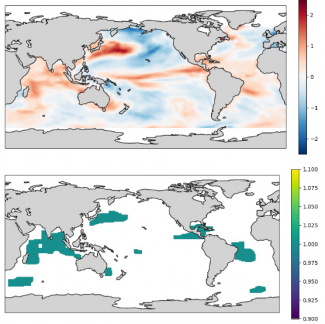The Method for Object-based Diagnostic Evaluation, commonly referred to as MODE, was originally developed to address the skill of forecasts of localized episodic phenomena such as rainfall (Davis et al 2006). The inclusion of this technique in the initial release of the Model Evaluation Tools (MET), the verification package developed and supported by the DTC, in 2008 has led to the exploration of an ever broadening application space for this useful tool. In 2009, the DTC collaborated with the NOAA Hydrometeorology Testbed (HMT) to explore the application of MODE to Atmospheric Rivers by applying MODE to observed and forecasted fields of integrated water vapor (IWV). Collaborations with HMT, as well as the NOAA Hazardous Weather Testbed, also explored the application of MODE to ensemble forecasts. From there, MODE has been used to examine the spatial and temporal characteristics of cloud cover forecasts from high-resolution NWP models with a novel approach used by Mittermaier and Bullock (2013) where they actually tracked cloud breaks instead of the clouds themselves. Applications related to clouds and precipitation have expanded over the years to include assessments of the Global Synthetic Weather Radar product and tropical cyclone quantitative precipitation forecasts (Newman et al 2023, Newman et al 2024) by the DTC, using infrared brightness temperatures to identify clouds (Griffin et al 2021), and an application to hail identification (Adams-Selin et al 2023).
While MODE was originally developed to address the needs for evaluating high-resolution NWP forecasts, its application has been expanded to include climate models. In particular, characterizing the location and predictability of the ITCZ in the Community Earth System Model Large Ensemble (CESM-LE), as well as temperature and precipitation anomalies associated with ENSO. In addition to expansions related to applications to the atmosphere, MODE has been applied to sea ice forecasts and more recently to the chlorophyll-a bloom season (Mittermaier et al 2021) and marine heatwaves (Cohen et al 2024). While most of the studies mentioned above involved collaborations with MET team members, its application to marine heatwaves was discovered through a recent workshop presentation. Jacob Cohen indicated he chose MODE for his research because of its flexibility, its widespread use over many applications, and its helpful documentation and user support.
Advancing the capabilities of MODE has continued since its inception to include the capability to track objects through time, referred to as MODE Time Domain or MODE-TD, and the capability to define objects based on multiple fields, referred to as Multivariate MODE. MODE-TD is being used to assess sea ice location and timing and fire spread, while Multivariate MODE is being applied to identify drylines, regions that meet red flag criteria based on relative humidity and winds and blizzard-like objects based on precipitation type, 10-m winds and visibility.
The applications described above should not be considered an exhaustive list given this information was gathered by soliciting input from DTC staff. The breadth of information gathered based on our internal knowledge suggests that a thorough literature review would likely produce a broader list of applications!
